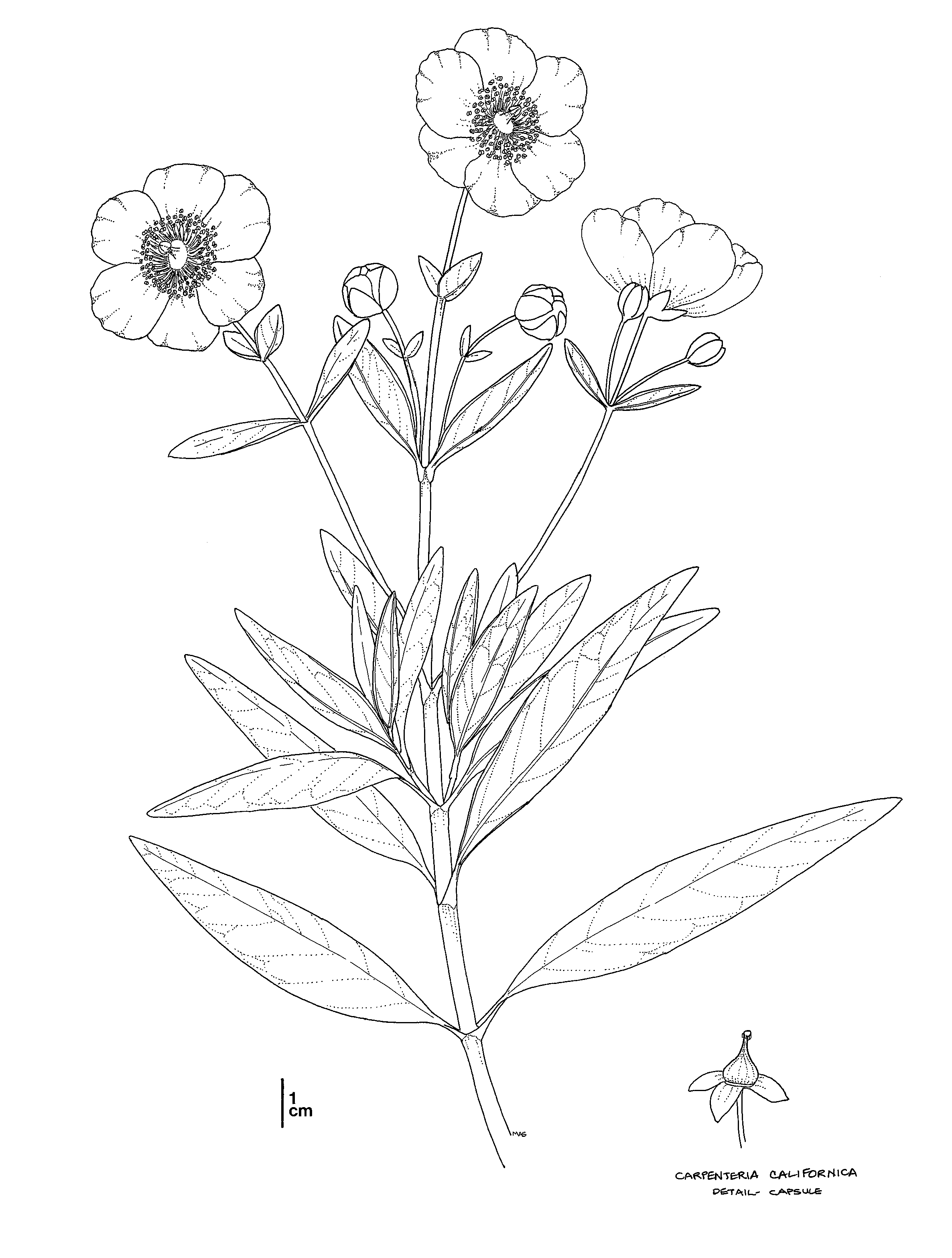(Carpenteria californica)
| Family |
Hydrangeaceae (Hydrangeas) |
| Life History |
Perennial shrub |
| Listing |
CESA Threatened |
| Range |
Fresno and Madera counties |
| CDFW Region |
Central Region (Region 4) |
Background
 CC photo by Chris Cameron.
CC photo by Chris Cameron.
 Carpenteria californica. CDFW illustration by Mary Ann Showers. (Click to enlarge)
Carpenteria californica. CDFW illustration by Mary Ann Showers. (Click to enlarge)
Tree-anemone (Carpenteria californica) is a California threatened plant species, which means that killing or possessing the plant is prohibited by the California Endangered Species Act (CESA). Tree-anemone is an evergreen shrub in the hydrangea family (Hydrangeaceae) growing up to three meters tall (9.8 ft) with shreddy, grey stems. The long elliptic leaves are opposite on the stem. Each flower is 3-6 cm (1.2-2.4 in) in diameter with five to eight papery white petals and many yellow stamens. The plant typically blooms from May through July, is pollinated by bumble bees (Bombus spp.), and eventually produces many tiny seeds. The leaves experience severe wilting in the summer, drooping and turning yellow but recovering after fall rains. Tree-anemone is also adapted to resprout after fire. Seedlings appear after fires, though few survive to maturity.
Tree-anemone is the sole species in the genus Carpenteria. The species may be a paleoendemic, having ancient origins and surviving past glaciations in narrow refugia.
Distribution
Tree-anemone grows between 340-1340 m (1115-4396 ft) in elevation on well-draining granitic soils in foothill woodland and chaparral communities. The California Natural Diversity Database lists 12 extant occurrences, primarily in central Fresno County between the San Joaquin and Kings rivers and in a small section of Madera County. The largest occurrence has several thousand individuals, and the smallest only has four. One occurrence is extirpated due to landfill and road construction.
All known populations except one are on federal land, either in the Sierra National Forest or on Bureau of Land Management property. The other population is within the Mary Elizabeth Miller Preserve at Black Mountain, and is managed by the Sierra Foothill Conservancy.
Conservation
Major threats to tree-anemone include fire suppression, trampling of seedlings, and competition with invasive plants such as yellow starthistle (Centaurea solstitialis). Because tree-anemone reproduction is stimulated by fire, the species may benefit from prescribed fire followed by protection of the seedlings from trampling as they mature. Other conservation strategies could include invasive species removal and conservation of the plant's bumble bee pollinators.
CDFW may issue permits for tree-anemone pursuant to CESA, and we invite you to learn more about the California laws protecting tree-anemone and other California native plants. Populations of tree-anemone occur in CDFW's Central Region.
References
Clines, J. M. 1990. Draft Species Management Guide for Carpenteria californica (Torr.). Sierra National Forest.
Clines, J. M. 1994. Reproductive ecology of Carpenteria californica (Philadelphaceae). Unpub. M.A. thesis, California State University, Fresno.
Dellavalle, J. and M. M. Sanwo. 1987. Carpenteria: an evolutionary enigma. Journal of Natural Sciences. 2: 15-17.
Preston, E. R. & C. F. Quibell. 2012. Carpenteria californica, in Jepson Flora Project (eds.) Jepson eFlora., accessed on November 17, 2025.
Sanwo, M. M. 1987. Leaf anatomy and pigment analysis of Carpenteria californica. Unpub. M.A. thesis, California State University, Fresno.
Stebbins, J. C. 1975. A vegetation study of the Carpenteria Botanical Area. M.A. thesis, California State University, Fresno.
Wickenheiser, L. P. 1989. Report to the Fish and Game Commission on the Status of Tree-anemone (Carpenteria californica). California Department of Fish and Wildlife. Natural Heritage Division Status Report 89-8.
Updated 11/20/2025